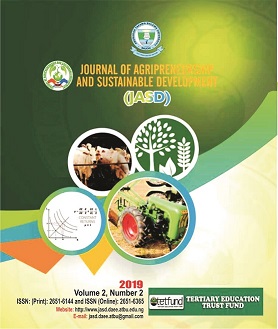IMPACT OF HADEJIA VALLEY IRRIGATION PROJECT ON POVERTY STATUS OF BENEFICIARIES IN JIGAWA STATE, NIGERIA
DOI:
https://doi.org/10.59331/jasd.v2i2.75Keywords:
Beneficiaries, Impact, Irrigation, Poverty, Project, Status, ValleyAbstract
The study was carried out to examine the impact of Hadejia valley irrigation project on poverty status of beneficiaries in Jigawa State, Nigeria. The study used multi-stage random sampling and selected 207 project beneficiaries and 146 non-beneficiaries out of a list of 7036 respondents making a total of 353 as the sample size for the study. Data were obtained using a structured questionnaire and analyzed; using descriptive statistics, t-test statistics and p-alpha poverty measure (Foster-Greer-Thorbecke Index) method. The results shows that beneficiaries and non-beneficiaries had a mean age of 47 and 45 years, a mean household size of 15 and 21, educational levels of 8 and 7 years and off-farm income that ranged from a mean of N137,797.00 to N 237,104.00. The study also revealed a mean of 30 and 24 years of irrigation farming experience, farm sizes of 3.2 and 2.1 hectares, N33,641.00 and N55, 709.00 spent in hiring labour, farm distances of 3 and 0.9 kilometres, 5 and 3 extension visits per season, a mean of N52,771.00 and N50,205.00, N50,205.68 and N32,422.33 as credit and subsidy, respectively. Membership of cooperative associations indicated a mean of 0.8 and 0.5. The result of the poverty measures indicated that 17% of beneficiaries were classified to be living below the poverty line of N12,489.00 while 36% of non-beneficiaries lived below the poverty line of N9,961.20. The poverty head count, depth and severity were 0.72, 0.12 and 0.088 for beneficiaries and 0.8, 0.28 and 0.23 for non-beneficiaries respectively. This meant that 72% and 80% of beneficiaries and non-beneficiaries were above the poverty line. But, 12% and 28% of beneficiaries’ and non-beneficiaries’ expenditure was required to bring them up to the poverty line. The results further show that poorest accounted for 9% and 28% of the beneficiaries and non-beneficiaries. The study concludes that Hadejia valley irrigation project had impacted on poverty status among its beneficiaries. It was therefore, recommended that the project beneficiaries should form farmers’ co-operatives and other farmer organizations for the purpose of knowledge transfer, input, output, marketing and distribution, savings mobilization, farm credit sourcing, supply and appropriate technologies that would release labour from irrigation to reduce the cost incurred in production.
Downloads

Downloads
Published
How to Cite
Issue
Section
License
Copyright (c) 2022 Journal of Agripreneurship and Sustainable Development

This work is licensed under a Creative Commons Attribution 4.0 International License.






